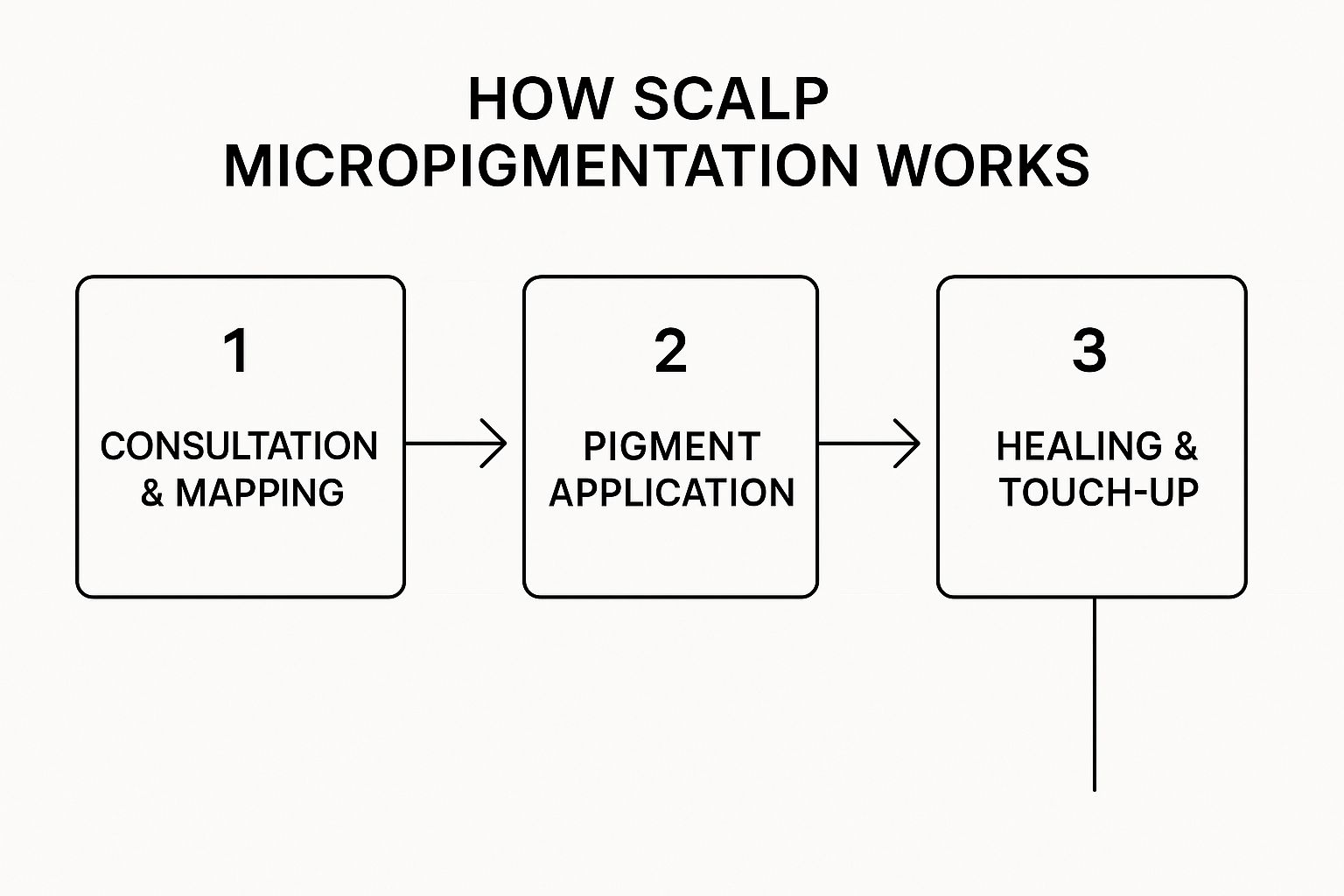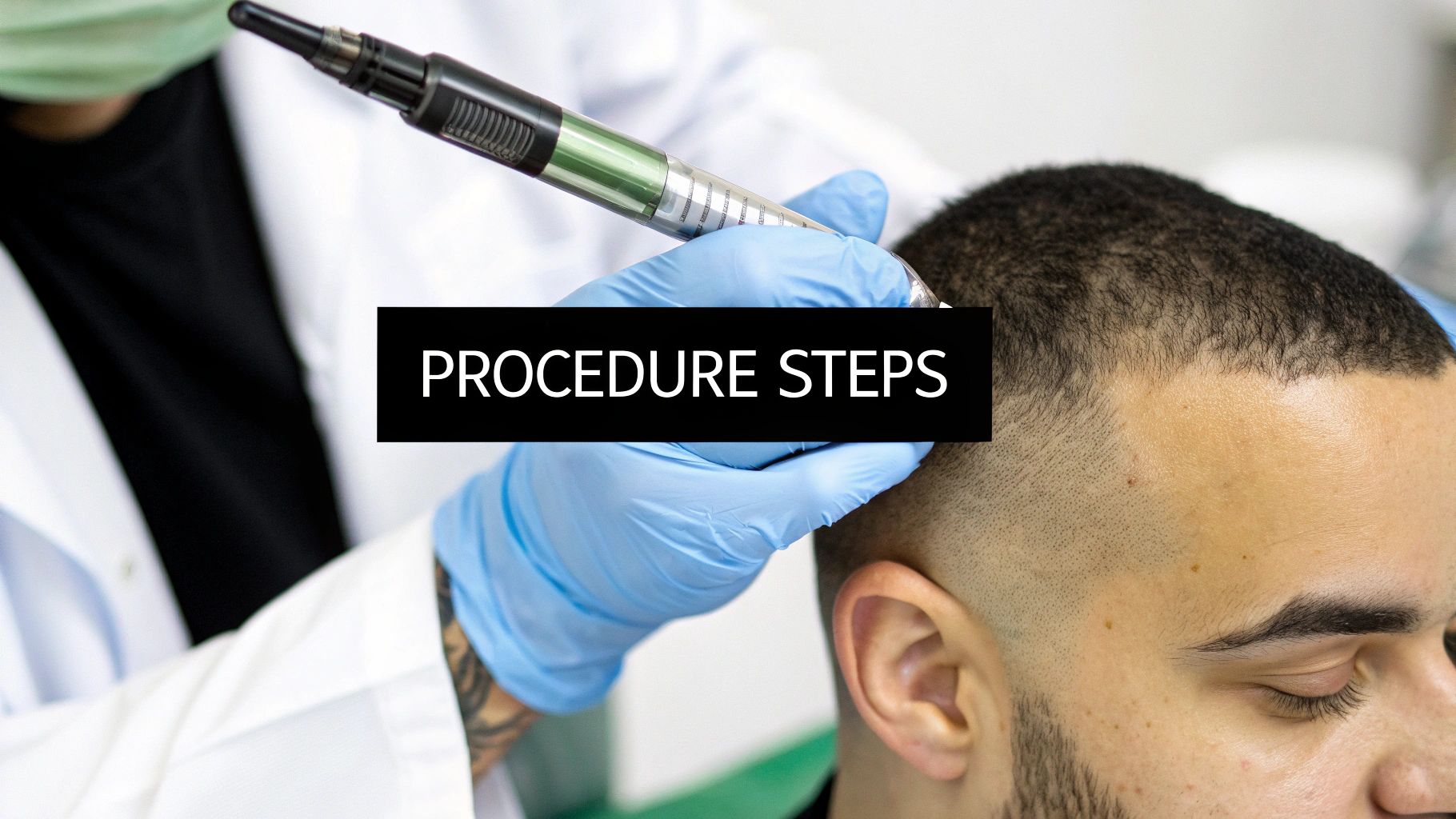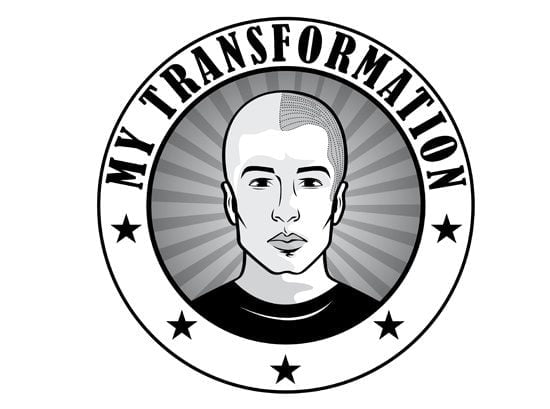
What Is Scalp Micropigmentation? Your Guide
Share
Let's get right down to it. Scalp Micropigmentation, or SMP, is a sophisticated cosmetic procedure that uses tiny, layered dots of pigment on the scalp to mimic the look of natural hair follicles. It's best to think of it as a highly specialised form of cosmetic tattooing, but one that’s laser-focused on creating the appearance of a fuller, denser head of hair.
So, What Is Scalp Micropigmentation, Really?

Scalp Micropigmentation is a non-surgical answer for anyone dealing with hair loss. It can create a sharp, clean buzz-cut look on a bald head or add the illusion of density to thinning areas. It’s not the same as a regular tattoo, though. SMP uses specialised pigments and equipment to create tiny impressions that look like real hair follicles, not solid lines of ink. This distinction is what makes the final result look so convincingly natural.
During the procedure, a skilled technician uses micro-fine needles to carefully deposit pigment into the upper layer of the scalp. This isn't a one-and-done deal; the process is repeated over several sessions. Each session builds upon the last, adding layers of impressions to create a three-dimensional effect that blends seamlessly with your existing hair.
Who Is A Good Candidate for SMP?
One of the best things about this technique is how versatile it is. It's a fantastic solution for a whole range of hair loss issues.
It's an effective option for:
- Men and women dealing with genetic thinning or pattern baldness.
- Anyone who wants to rock the look of a full, closely shaved head.
- People needing to camouflage scars from accidents or old hair transplant surgeries.
- Those looking to add visual density to thinning hair without going under the knife.
Scalp micropigmentation delivers an immediate visual boost. It's a reliable alternative for those who aren't candidates for surgery or simply prefer a non-invasive path.
To give you a quick, clear overview right from the start, we've put together a simple summary table. It breaks down what SMP is all about before we dive deeper into the specifics. For many people, the immediate and long-lasting results make them feel that scalp micropigmentation is the answer to hair loss.
Scalp Micropigmentation at a Glance
This table offers a snapshot of the key characteristics of the SMP treatment.
| Aspect | Description |
|---|---|
| Procedure Type | Non-surgical, cosmetic tattooing |
| Main Goal | Replicate hair follicles to create the illusion of density or a full head of hair |
| Ideal For | Thinning hair, receding hairlines, scar camouflage, buzz-cut style |
| Treatment Time | 2-4 sessions, each lasting 2-4 hours |
| Longevity | Semi-permanent; requires touch-ups every 3-6 years |
Now that you have the basic picture, let's explore how the process actually works and what you can expect from start to finish.
How the SMP Process Actually Works
So, you understand the what, but what about the how? It’s one thing to know SMP creates the look of hair, but how does that happen in real life? The entire process is a delicate dance between artistic vision and technical precision, all aimed at delivering a result that's both striking and completely natural-looking.
This isn’t a one-and-done appointment. Think of it more as a project unfolding over several weeks, giving you and your practitioner total control over the outcome. Each step carefully builds on the last, much like a master artist adding subtle layers to a painting until the final image is perfect.
The Initial Consultation and Design
Everything starts with a conversation. Honestly, this is probably the most crucial part of the whole journey because it lays the groundwork for everything that follows. During this initial chat, a skilled practitioner will sit down with you to really get to grips with a few key things:
- Your unique pattern of hair loss and the areas you want to address.
- Your skin type and undertones, which are vital for choosing the perfect pigment shade.
- The kind of look you’re after—are you picturing a soft, feathered hairline or something more sharp and defined?
With this information, your practitioner will sketch out a personalised plan. They’ll actually draw your proposed hairline right there on your scalp, so you can see exactly what to expect before a single drop of pigment is applied. It’s a collaborative effort to make sure you're 100% on board with the design.
Layering Pigment Over Multiple Sessions
Once you've signed off on the hairline and design, the real work begins. Using a highly specialised micro-needle, the practitioner starts depositing thousands of tiny pigment dots into the upper dermis of your scalp. These aren't just random dots; they're strategically placed to replicate the natural, staggered pattern of individual hair follicles.
The secret to a convincing result lies in the layering. An expert practitioner varies the depth, angle, and size of each tiny impression to build a truly three-dimensional effect. This is precisely why SMP can never be done in a single session.
Typically, the full treatment is spread across 2-4 separate sessions, with at least a week between each one to allow your skin to heal. This multi-session approach is non-negotiable for a quality result. It lets the pigment settle in, and gives the practitioner the chance to gradually build up density and make tiny adjustments for a finish that’s truly flawless.
This image gives you a great visual breakdown of the typical SMP journey.

As you can see, it’s a logical progression from planning and consultation through to the final, refined look, ensuring there are no surprises along the way.
Healing and Final Touch-Ups
After your last session, there's a brief healing phase. Your practitioner will arm you with a detailed aftercare guide to make sure you protect the treated area and help the pigment settle in perfectly. What you're left with is the seamless illusion of a full head of closely-shaved hair that needs next to no maintenance.
Of course, the investment for this kind of detailed, multi-stage procedure is a key factor for many people. To get a better idea of what's involved, you can check out our guide on how much scalp micropigmentation costs.
Is Scalp Micropigmentation Right for You?
Choosing a hair loss solution is a big decision, and it's a deeply personal one. Scalp micropigmentation is an incredibly versatile and effective option, but whether it’s the right one for you really boils down to your specific situation, your goals, and the type of hair loss you're experiencing.
SMP is a brilliant fix for many common hair loss patterns. It’s a complete game-changer for men with male pattern baldness who either want to rock a sharp, defined hairline with a buzz cut or just add some density. Likewise, women struggling with diffuse thinning can see a huge visual improvement, as the pigment cleverly reduces the contrast between the hair and scalp, giving the immediate illusion of thicker, fuller hair.
Ideal Scenarios for SMP
This treatment truly shines in a few key situations. Seeing how it works in the real world is the best way to figure out if it aligns with what you’re looking for.
SMP is an excellent choice if you want to:
- Create the look of a full head of shaved hair: For anyone who is completely bald or has a deeply receded hairline, SMP can perfectly mimic the look of a fresh, clean buzz cut.
- Add density to thinning hair: If your hair is just starting to thin out but you've still got reasonable coverage, SMP can fill in the sparser areas. This makes your existing hair look substantially thicker.
- Camouflage scars: Scars from accidents or, very commonly, from old hair transplant surgeries (like the long FUT strip scars) can be hidden remarkably well, blending them right into the scalp.
Think of SMP as a permanent, clever concealer for your scalp. It doesn't grow new hair, but it masterfully restores the look of hair follicles where they’ve been lost, giving you back that appearance of fullness.
When to Reconsider or Wait
As fantastic as SMP is, it’s not a magic wand for every single scalp condition. And it's important to be realistic about that. In some cases, you might not be a great candidate—or at least, not right now.
For example, if you have active and severe scalp acne, psoriasis, or dermatitis where you want the treatment, you absolutely need to get those conditions under control first. Trying to apply pigment to inflamed or irritated skin just won't give you a good result and could lead to healing issues. Any good practitioner will put your health first and advise you to sort out any skin problems before starting.
SMP is also a great tool for managing hair loss from conditions like alopecia areata. But the approach has to be customised to the specific pattern and how stable the condition is. For a deeper dive, you can learn more about how scalp micropigmentation for alopecia works in our dedicated guide.
Ultimately, the best way forward is always a proper consultation with a qualified technician. They can assess your scalp, understand what you hope to achieve, and give you an honest, professional opinion on whether SMP is the right journey for you.
How Does SMP Stack Up Against Other Hair Loss Treatments?

When you start looking into hair loss solutions, it’s easy to feel overwhelmed. There's a whole world of options out there, from surgical procedures to daily medications, and each one has its own rules, costs, and timelines. Figuring out where scalp micropigmentation fits into this picture is the key to making a decision you can feel good about.
Unlike most other treatments that aim to regrow hair or change your body's chemistry, SMP is a purely cosmetic approach. It doesn't grow a single hair. Instead, it masterfully creates the illusion of a full head of hair, giving you immediate visual results without the long, frustrating waiting game common with other methods.
SMP vs. Surgical Hair Transplants
The biggest difference between SMP and a hair transplant comes down to the fundamental approach. A hair transplant is a major surgical procedure where active hair follicles are taken from a donor area (usually the back of your head) and implanted into the balding or thinning spots. It's a genuine way to restore physical hair, but it's also highly invasive and comes with a significant recovery period.
SMP, on the other hand, is completely non-invasive. No surgery, no harvesting donor hair, and next to no downtime. This is a massive plus for anyone who isn't a good candidate for surgery or simply wants to avoid going under the knife.
Even the most advanced transplant methods, like Follicular Unit Extraction (FUE), take a long time to show their full potential—you're looking at 12 to 15 months to see the final outcome. With SMP, the change is visible right after your first session.
Another point to consider is scarring. Modern FUE techniques are much better than the old "strip" methods, but they still leave behind tiny dot-like scars in the donor area. In fact, a lot of our clients come to us specifically to cover up scars from past hair transplants. You can learn more about how we use scalp micropigmentation for hair transplant scars to make them disappear.
SMP vs. Topical and Oral Medications
Medications like topical Minoxidil and the oral tablet Finasteride are also common first-line defences against hair loss. They work by either stimulating dormant follicles or blocking the hormones responsible for hair thinning. But they have a few major drawbacks that really set them apart from SMP.
For starters, their results are notoriously inconsistent—what works wonders for one person might do very little for another. More importantly, they demand a lifelong commitment. The second you stop using them, any hair you've managed to hold onto or regrow will likely fall out. This means never-ending costs and the daily chore of applying a solution or popping a pill.
SMP is a much more straightforward solution. Once your initial sessions are done, you're set for years. There are no daily tasks, no prescriptions to refill, and no anxiously checking the mirror to see if it’s still working. Just a simple touch-up every few years to keep it looking fresh.
A Quick Comparison
To make things clearer, here’s a simple breakdown of how SMP compares to other popular hair loss solutions.
| Treatment | Cost | Invasiveness | Time to Results | Maintenance |
|---|---|---|---|---|
| Scalp Micropigmentation | $1,200 - $4,500+ | Non-invasive | Immediate | Low (touch-ups every 3-6 years) |
| Hair Transplant (FUE/FUT) | $5,000 - $30,000+ | Highly Invasive | 12-15 Months | High (potential for more surgery) |
| Minoxidil (Topical) | $30 - $60 per month | Non-invasive | 4-6 Months | High (twice-daily application) |
| Finasteride (Oral) | $30 - $90 per month | Non-invasive (systemic) | 3-6 Months | High (daily pill for life) |
As you can see, each option has its place. But for those looking for a guaranteed, immediate, and low-maintenance visual solution to hair loss, SMP stands out as a truly modern and effective choice. It gives you back the look of a full head of hair without the surgery, medication, or endless waiting.
Life After Your SMP Treatment
So, your final session is done and you're already seeing the incredible results. What's next? Honestly, how you look after your new SMP is just as crucial as the procedure itself. Good aftercare is what guarantees the pigment settles perfectly, your scalp heals without a hitch, and your results stay sharp for years.
Think of that first week as the "setting phase". Your main goal is to protect your scalp and just let the pigment do its thing. That means no water on your head for a few days and steering clear of anything that makes you sweat heavily, like a big gym session or a sauna. Your artist will give you a specific plan that’s right for your skin type.
Initial Aftercare: The First Few Weeks
The first bit of aftercare is pretty simple, but you have to be disciplined. It's all about locking in those crisp, defined hair follicle simulations. For the first four to five days, just be gentle.
Here are the golden rules:
- Don't wash your scalp: You need to give the pigment time to settle in, away from water and shampoo.
- No intense exercise: Sweat is the enemy here. It can literally push the pigment out before it has a chance to set properly in the dermis.
- Avoid direct sun: UV rays are the number one cause of fading for any kind of pigment. If you have to be outside, wear a loose-fitting hat.
- Hands off! Your scalp might get a little itchy as it heals, which is totally normal. But whatever you do, don't scratch or pick at it.
Sticking to these steps really sets the stage for a perfect, long-lasting result. For a more detailed day-by-day plan, you can check out our comprehensive scalp micropigmentation aftercare guide.
Long-Term Maintenance and Touch-Ups
Once your scalp is fully healed—which usually takes about a month—looking after it becomes incredibly easy. Your focus shifts from healing to preserving. The single best thing you can do for your SMP is protect it from the sun. Making a high-SPF, non-greasy sunscreen a part of your daily routine will make a massive difference in preventing any fading over time.
While we call scalp micropigmentation a permanent solution, the pigment will naturally soften and lighten over the years. I like to compare it to a high-quality photograph; with a bit of protection from the elements, it stays vibrant for much, much longer.
To keep the colour and definition looking its absolute best, most people come back for a touch-up every 3 to 6 years. This isn’t starting from scratch. It’s a quick, one-off session to refresh the pigment and restore that sharp, just-done look. Knowing you have this simple maintenance plan in place means you can enjoy that renewed confidence for the long haul.
Why SMP Is Gaining Traction in Australia

Scalp micropigmentation has moved out of the shadows and is now a go-to solution for thousands of men and women right across Australia. It's no longer a niche secret. The reason behind its massive surge in popularity is pretty simple: it’s a dependable, modern fix that aligns perfectly with the active, sun-soaked Aussie lifestyle.
Unlike older hair loss treatments that come with a long list of rules or constant upkeep, SMP offers genuine freedom. It gives you a clean, sharp look that's incredibly low-maintenance and stands up to anything life throws at it. Whether you're hitting the surf, sweating it out at the gym, or presenting in the boardroom, the look holds. This sheer practicality is a huge part of its appeal for Aussies who just want something that works without any fuss.
A Modern Look for a Modern Country
The clean buzz-cut style or the appearance of thicker, denser hair has never been more in demand, and SMP nails that look every time. It creates a defined, neat appearance that feels current and sharp. A big part of this trend is the growing trust in the procedure, driven by the impressive standards and professionalism found in clinics across the country.
SMP’s rise in Australia is really a story about reliability meeting results. It has cemented its place as a trusted cosmetic treatment because it consistently delivers what people are searching for: a natural-looking, hassle-free answer to hair loss.
Australia's leading clinics have been at the heart of this growth. By performing thousands of successful procedures, they've made the treatment more visible and accessible than ever before. You can now find skilled practitioners in major cities like Sydney, Melbourne, and Perth, with most offering free consultations to get you started. To see what these specialists are achieving, you can learn more about leading Australian SMP clinics.
It's this blend of a desirable aesthetic, suitability for our active way of life, and the availability of highly skilled local artists that explains why SMP has truly arrived. It's now a proven, mainstream choice for Australians looking for a fresh, confident look.
Got Questions About SMP? We've Got Answers
It's completely normal to have a few lingering questions, even after learning all about the process. Getting into the nitty-gritty details is what helps you feel truly confident and ready to take the next step. Let’s tackle some of the most common things people ask about scalp micropigmentation.
Does it Hurt? What About the Cost?
Let's start with the big one: pain. Honestly, most of our clients are pleasantly surprised. They usually describe the feeling as a light, annoying sensation rather than actual pain, typically rating it a 2 or 3 out of 10 on the pain scale. The needles are incredibly fine and only just break the surface of the skin, so it’s much less intense than getting a regular tattoo. We also apply a topical numbing cream before we start to make sure you're as comfortable as possible.
Another practical question is always about the investment. In Australia, you can expect a full scalp micropigmentation treatment to cost anywhere from $1,200 to over $4,000 AUD. The final price really comes down to a few things: the size of the area we're treating, how much hair loss you have, and if we need to do any detailed work to camouflage scars.
How Long Does it Last and Will it Look Real?
This is where a skilled technician makes all the difference. When done right, the results are incredibly realistic. A true professional doesn't just use one shade of pigment; they blend multiple shades and carefully vary the size and density of the impressions. This creates a convincing 3D effect that perfectly mimics the look of real, individual hair follicles. The key to avoiding that fake, "pluggy" look is finding a practitioner who can show you a portfolio of natural-looking results.
SMP is designed to be a permanent solution. That said, the pigment will fade very gradually over the years, mostly due to things like sun exposure and your skin's natural renewal process.
This brings us to maintenance. To keep the look sharp and defined, most people find they need a quick touch-up session every 3 to 6 years. This isn't like starting from scratch; it's just a simple refresh to boost the colour and keep everything looking its best.
Ready to explore how scalp micropigmentation can restore your confidence? At My Transformation, Michael is dedicated to providing a personalised solution for your hair loss. Book your free consultation today and take the first step.
Article created using Outrank
